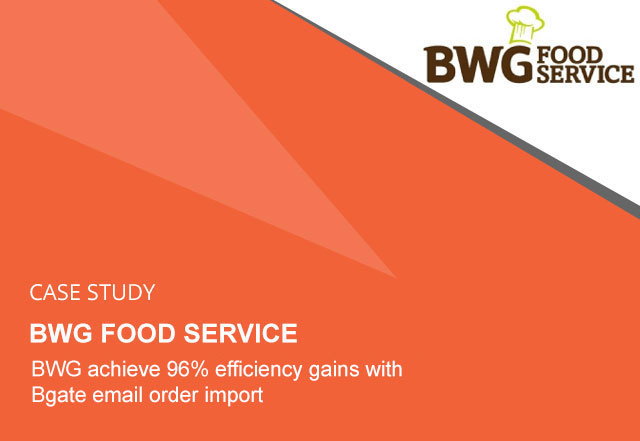
BWG Foodservice Case Study
95.6% time saving with Bgate EXTRACT Email Order Import
Background
In early January 2018 BWG approached Bgate to streamline their handling of emailed orders.
BWG Foodservice receive on average 90 customer orders per day by email.
Emails are generated and sent by BWG customer/buyer-side systems. e.g. ERP, Purchasing systems, POS systems to BWG. Most of these emails contain PDF attachments, other formats include HTML attachments, CSV files and tabular data within the email body.
Problem
Their existing process involved printing out order attachments and re-keying the orders into the BWG in-house order processing system.
Order data would invariably need to be modified due to the inadequacies of the source systems:
- missing or out-of-date product codes
- out-of-date pricing
- missing customer codes
- source systems did not carry supplier depot or delivery schedule information
The task of re-keying the orders was prone to error and a tedious job that required the focus of skilled tele sales staff. They needed to be not only familiar with current BWG product listings, but also have an intimate knowledge of the customer, their contract, and their buying history.
The Solution
Bgate designed a solution that had tackled the above process from two directions.
1.Data-capture
Bgate would deploy Bgate Extract to parse the data from incoming emails and import directly to the Bgate procurement platform.
Once the order is in Bgate, BWG would have full visibility and control of the orders. Delivery schedules and customer/depot codes etc. could be auto-inserted and BWG could export directly to their system.
This eliminated the manual entry component of the process.
Development
To achieve this, Bgate needed to integrate directly with the BWG in-house systems.
Step one was to build an exporter on Bgate that formatted orders into a tailored XML format that could be sent straight to the in-house system from the Bgate supplier dashboard.
Bgate already had a working invoice integration with BWG.
The order export/import was complete and tested on both systems 1 month after Project kick-off. Once in place Bgate Extract went live with order import.
2.Data-mapping
Bgate’s solution took automation a step further. With all the data captured and flowing through Bgate; the need for skilled staff intervention to “interpret” the details on an email order could be eliminated in about 90% of cases.
Once Bgate had an up-to-date product list and the order history of every customer, the system could produce swap tables for out-of-date product codes.
With product code mapping in place, the only staff intervention needed was to read customer-entered comments and instructions that appear from time to time.
Development
To achieve this, Bgate and BWG developed an overnight product data synchronisation.
Development on BWG side required input from a number of parties and was completed and tested 1 month after Extract had gone live.
The entire 22,000 product inventory of BWG is uploaded to Bgate every night in 3 components.
- Master product data file, containing current product details, units VAT rates, pack sizes etc.
- Group contract files, containing updated product listings and prices for customer groups
- Buyer price files, containing outlet specific product and price listings for non-group customers.
Once in place, Bgate added a validation step to the importer. Bgate compares the email product codes against the current product database. Out-of-data product codes are swapped out for current codes using lookup tables that are auto- populated and then managed from the Supplier dashboard.
This eliminated the tedious task of manually changing product codes and freed up staff for more high-value and rewarding work.
Results-Efficiency Gain Study

INPUT1
Time on task Before
Average of 1800 email
Average of 1800 email per month Average of Items 10 per order
5 minutes to Open, Print, enter order 5×1800 = 9000 minutes per month time on task INPUT1 = 450 minutes
INPUT2
Time on task Before
Emails are auto-forwarded to Bgate Extract BWG access and manage orders on Bgate
11% orders contain comments that must be read and order amended if necessary Average time to read and action commented order = 2 minutes
11% of 1800 = 198 orders with comments per day INPUT 2 = 396 minutes
